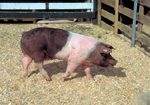| Sustainable Food Guide | Environmental Practice at Work © 2005  |
Issues
| Hygiene Information... Salmonella infects more than 160 000 individuals in the EU annually of which it is estimated that around 200 die. The overall frequency of Salmonella contamination in retail chicken in the UK in 2002 was 5.7% and is much lower than previous national surveys undertaken for whole chicken by the Advisory Committee on the Microbiological Safety of Food (ACMSF). There were differences between the four countries in the UK with Wales having the lowest frequency of Salmonella contamination (3.4%), with England and Northern Ireland both having a contamination rate of 5.5%. Scotland had the highest frequency of contamination (8.8%). Salmonella and Campylobacter Survey. Campylobacter now heads the league tables of the causes of food-borne infections. About half of chicken meat in Europe is contaminated with campylobacter, which is carried in the faeces. The FSA has targeted chicken farmers across the UK with best practice advice on hygiene measures for chicken farms with its leaflet Cleaner Farms, Better Flocks.The FSA strategy is to reduce the number of contaminated birds entering the kitchen, although they still advise consumers to cook chickens thoroughly. No targets have been set for either contamination or poisoning. It is estimated that 3 cases of salmonella occur for every 1 reported. Reported cases of Salmonellosis in people have fallen since 1998 mainly as a result of monitoring and measures introduced by the poultry industry and greater application of Assurance schemes. DEFRA introduced a Code of Practice in 2002.
| ||||||||
| Photos courtesy of http://www.usda.gov |


